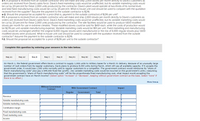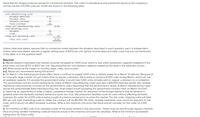
FINANCIAL ACCOUNTING
10th Edition
ISBN: 9781259964947
Author: Libby
Publisher: MCG
expand_more
expand_more
format_list_bulleted
Question
Davis kitchen supply produces stoves for commerical kitchens.
Help with Req. B, Req C, Reg D

Transcribed Image Text:e-1. A proposal is received from an outside contractor who will make and ship 2,000 stoves per month directly to Davis's customers as
orders are received from Davis's sales force. Davis's fixed marketing costs would be unaffected, but its variable marketing costs would
be cut by 20 percent for these 2,000 units produced by the contractor. Davis's plant would operate at two-thirds of its normal level,
and total fixed manufacturing costs would be cut by 25 percent. What in-house unit cost should be used to compare with the quotation
received from the supplier? Assume the payment to the outside contractor is $216.
e-2. Should the proposal be accepted for a price (that is, payment to the outside contractor) of $216 per unit?
f-1. A proposal is received from an outside contractor who will make and ship 2,000 stoves per month directly to Davis's customers as
orders are received from Davis's sales force. Davis's fixed marketing costs would be unaffected, but its variable marketing costs would
be cut by 20 percent for these 2,000 units produced by the contractor. The idle facilities would be used to produce 1,600 modified
stoves per month for use in extreme climates. These modified stoves could be sold for $451 each, while the costs of production would
be $276 per unit variable manufacturing expense. Variable marketing costs would be $51 per unit. Fixed marketing and manufacturing
costs would be unchanged whether the original 6,000 regular stoves were manufactured or the mix of 4,000 regular stoves plus 1,600
modified stoves were produced. What in-house unit cost should be used to compare with the quotation received from the outside
contractor? Assume the payment to the outside contractor is $216.
f-2. Should the proposal be accepted for a price of $216 per unit to the outside contractor?
Complete this question by entering your answers in the tabs below.
Reg A1
Req A2
Reg B
Reg C
Reg D
Reg E1
Reg E2
Reg F1
Reg F2
On March 1, the federal government offers Davis a contract to supply 1,000 units to military bases for a March 31 delivery. Because of an unusually large
number of rush orders from its regular customers, Davis plans to produce 8,000 units during March, which will use all available capacity. If it accepts the
government order, it would lose 1,000 units normally sold to regular customers to a competitor. The government contract would reimburse its "share of
March manufacturing costs" plus pay a $49,000 fixed fee (profit). (No variable marketing costs would be incurred on the government's units.) Assuming
that the government's "share of March manufacturing costs" will be the proportionate fixed manufacturing cost, what impact would accepting the
government contract have on March income? (Select option "increase" or "decrease", keeping without government contract as the base. Select "none" if
there is no effect.)
Show less A
Without Government
With Government Contract
Impact
Contract
Regular
Government
Total
Revenue
Variable manufacturing costs
Variable marketing costs
Contribution margin
Fixed manufacturing costs
Fixed marketing costs
Income

Transcribed Image Text:Davis Kitchen Supply produces stoves for commercial kitchens. The costs to manufacture and market the stoves at the company's
normal volume of 6,000 units per month are shown in the following table.
Unit manufacturing costs
Variable materials
$ 51
Variable labor
76
Variable overhead
26
Fixed overhead
61
$ 214
Total unit manufacturing costs
Unit marketing costs
Variable
26
Fixed
71
Total unit marketing costs
97
Total unit costs
$ 311
Unless otherwise stated, assume that no connection exists between the situation described in each question; each is independent.
Unless otherwise stated, assume a regular selling price of $372 per unit. Ignore income taxes and other costs that are not mentioned
in the table or in the question itself.
Required:
a. Market research estimates that volume could be increased to 7,000 units, which is well within production capacity limitations if the
price were cut from $372 to $327 per unit. Assuming that the cost behavior patterns implied by the data in the table are correct.
a-1. What would be the impact on monthly sales, costs, and income?
a-2. Would you recommend taking this action?
b. On March 1, the federal government offers Davis a contract to supply 1,000 units to military bases for a March 31 delivery. Because of
an unusually large number of rush orders from its regular customers, Davis plans to produce 8,000 units during March, which will use
all available capacity. If it accepts the government order, it would lose 1,000 units normally sold to regular customers to a competitor.
The government contract would reimburse its "share of March manufacturing costs" plus pay a $49,000 fixed fee (profit). (No variable
marketing costs would be incurred on the government's units.) Assuming that the government's "share of March manufacturing costs"
will be the proportionate fixed manufacturing cost, what impact would accepting the government contract have on March income?
c. Davis has an opportunity to enter a highly competitive foreign market. An attraction of the foreign market is that its demand is
greatest when the domestic market's demand is quite low; thus, idle production facilities could be used without affecting domestic
business. An order for 2,000 units is being sought at a below-normal price to enter this market. For this order, shipping costs will total
$41 per unit; total (marketing) costs to obtain the contract will be $6,000. No other variable marketing costs would be required on this
order, and it would not affect domestic business. What is the minimum unit price that Davis should consider for this order of 2,000
units?
d. An inventory of 460 units of an obsolete model of the stove remains in the stockroom. These must be sold through regular channels
(thus incurring variable marketing costs) at reduced prices or the inventory will soon be valueless. What is the minimum acceptable
selling price for these units?
Expert Solution
This question has been solved!
Explore an expertly crafted, step-by-step solution for a thorough understanding of key concepts.
This is a popular solution
Trending nowThis is a popular solution!
Step by stepSolved in 4 steps with 6 images

Knowledge Booster
Learn more about
Need a deep-dive on the concept behind this application? Look no further. Learn more about this topic, accounting and related others by exploring similar questions and additional content below.Similar questions
- Hh Module 1-30691202003 * My Home CengageNOWv2 | Online teachir x Cengage Learning v2.cengagenow.com/ilrn/takeAssignment/takeAssignmentMain.do?invoker%3D&takeAssignmentSessionLocator=&inprogress%3Dfalse Entries for Flow of Factory Costs for Process Cost System Radford Inc. manufactures a sugar product by a continuous process, involving three production departments-Refining, Sifting, and Packing. Assume that records indicate that direct materials, direct labor, and applied factory overhead for the first department, Refining, were $585,800, $205,000, and $134,700, respectively. Also, work in process in the Refining Department at the beginning of the period totaled $32,800, and work in process at the end of the period totaled $40,400. a. Journalize the entries to record the flow of costs into the Refining Department during the perlod for (1) direct materials, (2) direct labor, and (3) factory overhead. If an amount box does not require an entry, leave it blank. Work In Process-Refining…arrow_forwardView Policies Current Attempt in Progress In which of the following categories do indirect materials belong? Product Cost Manufacturing Overhead Period Cost No No Yes Yes No No Yes Yes No Yes Yes Yes eTextbook and Media Save for Later O Attempts: 0 of 3 used Submit Answerarrow_forwardplease answer within the format by providing formula the detailed workingPlease provide answer in text (Without image)Please provide answer in text (Without image)Please provide answer in text (Without image)arrow_forward
- please help and provide solution for all requirements or just skip/leave for other experts please answer with all working answer in text please remember need answer all requirements.upvote if complete and correct downvote if incomplete or incorrectarrow_forwardhelp please answer in text form with proper workings and explanation for each and every part and steps with concept and introduction no AI no copy paste remember answer must be in proper format with all workingarrow_forwardAll of the following would be considered a direct material for a kitchen cabinet except A. wood. OB. sandpaper. OC. stain. OD. hinges.arrow_forward
- please answer with explanation , computation , formulation and steps thanks for help in advance please no copy paste from other answer need complete and correct answer for all or skip / leave answer in text not image please remember answer all clearlyarrow_forwardI want last three requirement with detail working I want last three requirement with detail working I want last three requirement with detail working please answer within the format by providing formula the detailed workingPlease provide answer in text (Without image)Please provide answer in text (Without image)Please provide answer in text (Without image)arrow_forwardplease answer within the format by providing formula the detailed workingPlease provide answer in text (Without image)Please provide answer in text (Without image)Please provide answer in text (Without image)arrow_forward
arrow_back_ios
arrow_forward_ios
Recommended textbooks for you

 AccountingAccountingISBN:9781337272094Author:WARREN, Carl S., Reeve, James M., Duchac, Jonathan E.Publisher:Cengage Learning,
AccountingAccountingISBN:9781337272094Author:WARREN, Carl S., Reeve, James M., Duchac, Jonathan E.Publisher:Cengage Learning, Accounting Information SystemsAccountingISBN:9781337619202Author:Hall, James A.Publisher:Cengage Learning,
Accounting Information SystemsAccountingISBN:9781337619202Author:Hall, James A.Publisher:Cengage Learning, Horngren's Cost Accounting: A Managerial Emphasis...AccountingISBN:9780134475585Author:Srikant M. Datar, Madhav V. RajanPublisher:PEARSON
Horngren's Cost Accounting: A Managerial Emphasis...AccountingISBN:9780134475585Author:Srikant M. Datar, Madhav V. RajanPublisher:PEARSON Intermediate AccountingAccountingISBN:9781259722660Author:J. David Spiceland, Mark W. Nelson, Wayne M ThomasPublisher:McGraw-Hill Education
Intermediate AccountingAccountingISBN:9781259722660Author:J. David Spiceland, Mark W. Nelson, Wayne M ThomasPublisher:McGraw-Hill Education Financial and Managerial AccountingAccountingISBN:9781259726705Author:John J Wild, Ken W. Shaw, Barbara Chiappetta Fundamental Accounting PrinciplesPublisher:McGraw-Hill Education
Financial and Managerial AccountingAccountingISBN:9781259726705Author:John J Wild, Ken W. Shaw, Barbara Chiappetta Fundamental Accounting PrinciplesPublisher:McGraw-Hill Education


Accounting
Accounting
ISBN:9781337272094
Author:WARREN, Carl S., Reeve, James M., Duchac, Jonathan E.
Publisher:Cengage Learning,

Accounting Information Systems
Accounting
ISBN:9781337619202
Author:Hall, James A.
Publisher:Cengage Learning,

Horngren's Cost Accounting: A Managerial Emphasis...
Accounting
ISBN:9780134475585
Author:Srikant M. Datar, Madhav V. Rajan
Publisher:PEARSON

Intermediate Accounting
Accounting
ISBN:9781259722660
Author:J. David Spiceland, Mark W. Nelson, Wayne M Thomas
Publisher:McGraw-Hill Education

Financial and Managerial Accounting
Accounting
ISBN:9781259726705
Author:John J Wild, Ken W. Shaw, Barbara Chiappetta Fundamental Accounting Principles
Publisher:McGraw-Hill Education